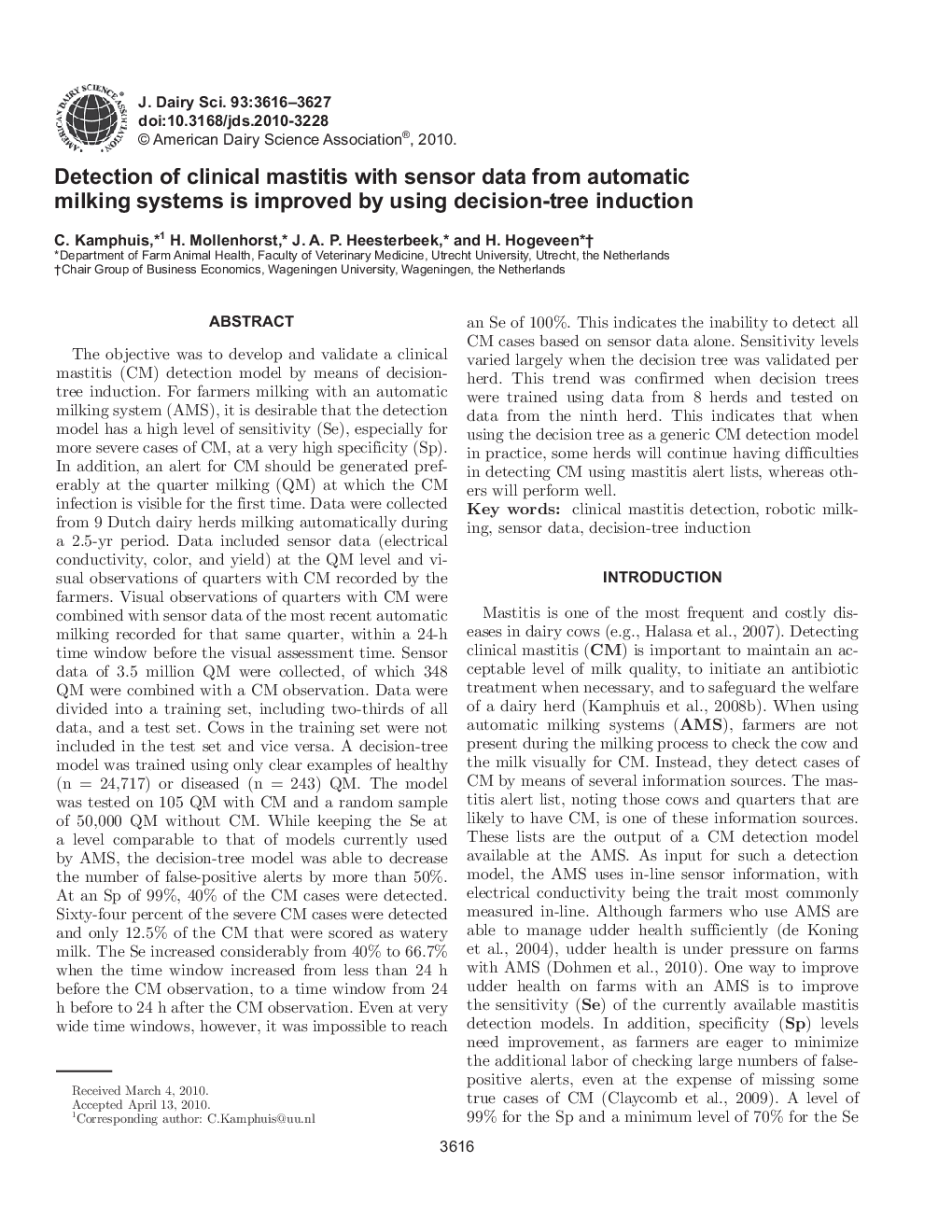| کد مقاله | کد نشریه | سال انتشار | مقاله انگلیسی | نسخه تمام متن |
|---|---|---|---|---|
| 10980900 | 1108073 | 2010 | 12 صفحه PDF | دانلود رایگان |
عنوان انگلیسی مقاله ISI
Detection of clinical mastitis with sensor data from automatic milking systems is improved by using decision-tree induction
دانلود مقاله + سفارش ترجمه
دانلود مقاله ISI انگلیسی
رایگان برای ایرانیان
کلمات کلیدی
موضوعات مرتبط
علوم زیستی و بیوفناوری
علوم کشاورزی و بیولوژیک
علوم دامی و جانورشناسی
پیش نمایش صفحه اول مقاله

چکیده انگلیسی
The objective was to develop and validate a clinical mastitis (CM) detection model by means of decision-tree induction. For farmers milking with an automatic milking system (AMS), it is desirable that the detection model has a high level of sensitivity (Se), especially for more severe cases of CM, at a very high specificity (Sp). In addition, an alert for CM should be generated preferably at the quarter milking (QM) at which the CM infection is visible for the first time. Data were collected from 9 Dutch dairy herds milking automatically during a 2.5-yr period. Data included sensor data (electrical conductivity, color, and yield) at the QM level and visual observations of quarters with CM recorded by the farmers. Visual observations of quarters with CM were combined with sensor data of the most recent automatic milking recorded for that same quarter, within a 24-h time window before the visual assessment time. Sensor data of 3.5 million QM were collected, of which 348 QM were combined with a CM observation. Data were divided into a training set, including two-thirds of all data, and a test set. Cows in the training set were not included in the test set and vice versa. A decision-tree model was trained using only clear examples of healthy (n = 24,717) or diseased (n = 243) QM. The model was tested on 105 QM with CM and a random sample of 50,000 QM without CM. While keeping the Se at a level comparable to that of models currently used by AMS, the decision-tree model was able to decrease the number of false-positive alerts by more than 50%. At an Sp of 99%, 40% of the CM cases were detected. Sixty-four percent of the severe CM cases were detected and only 12.5% of the CM that were scored as watery milk. The Se increased considerably from 40% to 66.7% when the time window increased from less than 24 h before the CM observation, to a time window from 24 h before to 24 h after the CM observation. Even at very wide time windows, however, it was impossible to reach an Se of 100%. This indicates the inability to detect all CM cases based on sensor data alone. Sensitivity levels varied largely when the decision tree was validated per herd. This trend was confirmed when decision trees were trained using data from 8 herds and tested on data from the ninth herd. This indicates that when using the decision tree as a generic CM detection model in practice, some herds will continue having difficulties in detecting CM using mastitis alert lists, whereas others will perform well.
ناشر
Database: Elsevier - ScienceDirect (ساینس دایرکت)
Journal: Journal of Dairy Science - Volume 93, Issue 8, August 2010, Pages 3616-3627
Journal: Journal of Dairy Science - Volume 93, Issue 8, August 2010, Pages 3616-3627
نویسندگان
C. Kamphuis, H. Mollenhorst, J.A.P. Heesterbeek, H. Hogeveen,